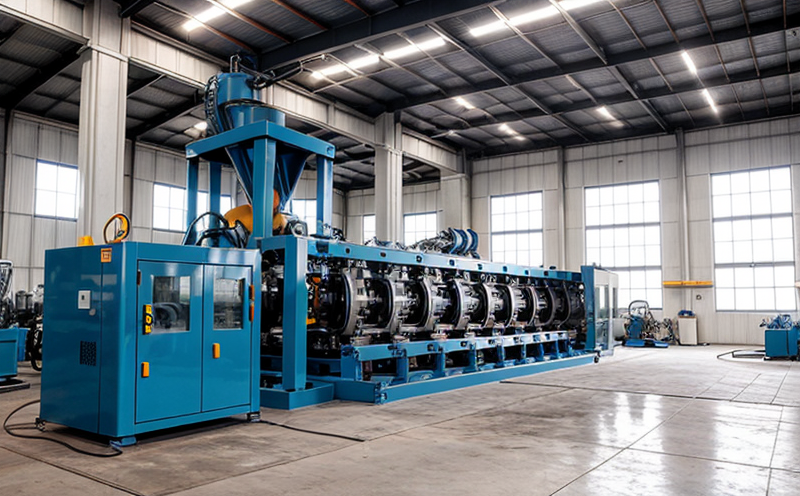ASTM E208 Drop Weight Performance Testing of Steels for Machinery
The ASTM E208 standard provides a critical method for evaluating the dynamic mechanical properties and toughness of steels, especially in machinery manufacturing. This testing is particularly important for components that are subjected to severe impact or sudden loading conditions, such as gears, shafts, and other parts found in heavy-duty industrial applications.
The drop weight test subjects a sample to a controlled high-velocity impact from a falling hammer. The specimen’s resistance to fracture under this dynamic load is assessed by measuring the distance it deflects upon impact or the energy absorbed before failure. This data provides valuable insights into the material's toughness and its ability to absorb shock without catastrophic failure.
The test setup involves a pendulum that swings freely until it strikes the sample, which is supported on a rigid base. The hammer falls from a specified height onto the specimen placed between two anvils. The impact energy can be varied by adjusting the height of the fall or the mass of the hammer. This flexibility allows for testing under different conditions to simulate real-world operational scenarios.
Specimen preparation is critical in ASTM E208 testing. Samples are typically cut from production parts, ensuring they represent the actual material used in machinery components. The specimens must be machined to precise dimensions and finish, often requiring specialized cutting techniques to avoid introducing artificial weaknesses or stresses into the test sample.
The apparatus for drop weight testing includes a pendulum with an adjustable release mechanism, anvils of appropriate size and shape, and a rigid base that can withstand high-impact loads without deformation. The equipment must be calibrated regularly to ensure accurate measurements of impact energy and specimen deflection or fracture behavior.
Testing parameters are meticulously controlled to standardize the test conditions. Factors such as hammer mass, fall height, environmental conditions (temperature), and sample orientation are carefully documented for each test run. This ensures repeatability and comparability across different tests and laboratories.
The results of ASTM E208 testing provide critical data that can influence design choices and quality assurance strategies in industrial machinery manufacturing. Engineers use this information to optimize the material selection, heat treatment processes, and component design for better performance under dynamic loading conditions.
By adhering to ASTM E208 standards, manufacturers ensure compliance with industry best practices and international quality benchmarks. This helps maintain a high level of product reliability and safety in machinery applications across various sectors such as automotive, aerospace, and construction industries.
- International Acceptance: ASTM E208 is widely recognized and accepted by major industrial nations including the United States, Europe, and Asia. Its use ensures consistency in testing methodologies across borders.
- Compliance: Compliance with ASTM E208 helps companies meet regulatory requirements for machinery safety and quality assurance standards.
Applied Standards
The ASTM E208 standard is part of a broader suite of testing protocols that are essential in the industrial manufacturing sector. These include:
- ASTM E55: This covers definitions and terminology used in mechanical testing, which provides a common language for interpreting test results.
- ASTM E841: This standard specifies procedures for the tensile testing of metallic materials. While not directly related to drop weight testing, it complements ASTM E208 by providing insights into material properties under different loading conditions.
- ASTM E965: This covers dynamic elongation of metallic materials at elevated temperatures, which is relevant when considering the performance of machinery components in high-temperature environments.
The interrelation of these standards ensures comprehensive evaluation of steel properties under various loading scenarios. By adhering to multiple ASTM standards, manufacturers can ensure a holistic approach to quality control and product design.
International Acceptance and Recognition
- America: ASTM E208 is widely used in the United States for its stringent testing requirements. American machinery manufacturers rely on this standard to ensure the reliability of their products.
- Europe: The European Union also recognizes ASTM E208, particularly in industries where high-toughness materials are critical for safety and performance.
- Asia-Pacific: Countries such as Japan, China, and India have adopted ASTM E208 to standardize testing practices within their respective manufacturing sectors.
The global acceptance of ASTM E208 underscores its importance in ensuring that machinery components meet the highest quality standards regardless of geographical location. This international recognition also facilitates trade between countries by providing a common benchmark for material performance evaluation.
Environmental and Sustainability Contributions
ASTM E208 testing plays a role in promoting environmental sustainability through its contribution to the development of more durable and reliable machinery. By ensuring that components meet high toughness standards, manufacturers can design products that last longer with fewer replacements or repairs.
- Eco-friendly Design: Durable parts reduce waste by minimizing the need for frequent replacement, thereby extending the lifecycle of industrial equipment.
- Energy Efficiency: Longer-lasting machinery components contribute to overall energy efficiency in manufacturing processes. This is especially important as industries strive to reduce their carbon footprints.
Incorporating ASTM E208 standards into product design and testing protocols helps manufacturers meet sustainability goals while maintaining operational excellence. The use of this standard ensures that materials selected for machinery are robust enough to withstand the rigors of industrial environments without compromising safety or performance.





